Page 401 of 522

CAUTION!
Damage to the transmission may occur if the trans-
mission is shifted into PARK with the transfer case in
NEUTRAL and the engine RUNNING. With the
transfer case in NEUTRAL, ensure that the engine is
OFF prior to shifting the transmission into PARK.
Shifting Out of NEUTRAL
Perform the following procedure to prepare your vehicle
for normal usage:
1. Bring the vehicle to a complete stop.
2. Reconnect the negative battery cable.
3. Place the ignition switch in the LOCK position (if it
has been moved or the engine has been started).
4. Turn the ignition switch to the ON position, but do not
start the engine.5. Press the brake pedal.
6. Shift the transmission into NEUTRAL.
7. Use the point of a ballpoint pen or similar object to
press the recessed transfer case NEUTRAL button. Re-
lease the NEUTRAL button after the NEUTRAL indicator
light turns off (approximately one second). After the
NEUTRAL button is released, the transfer case will shift
to the position identified by the selector switch.
8. Start the engine.
9. Shift the transmission into DRIVE.
10. Set the parking brake.
11. Shift the transmission into PARK.
400 STARTING AND OPERATING
Page 405 of 522
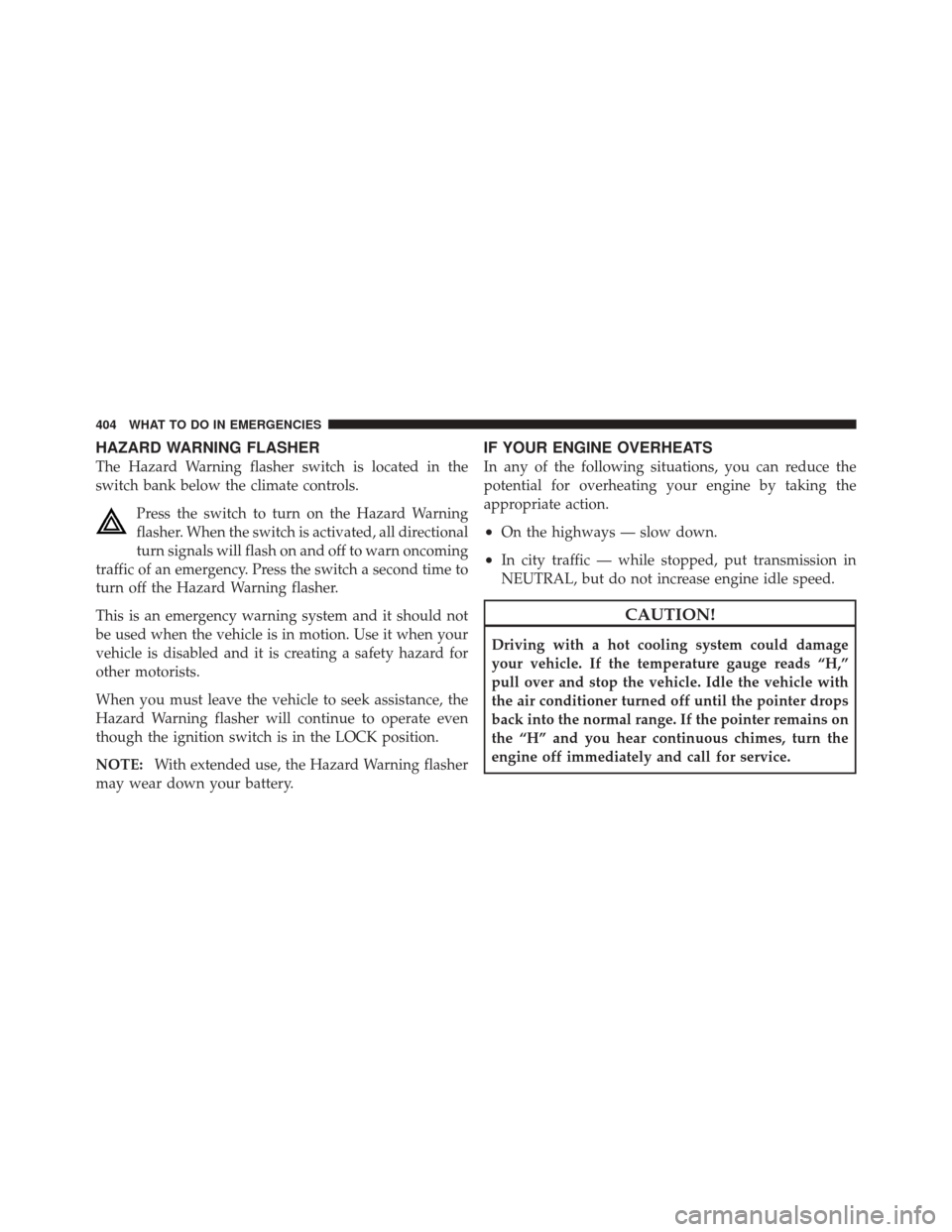
HAZARD WARNING FLASHER
The Hazard Warning flasher switch is located in the
switch bank below the climate controls.Press the switch to turn on the Hazard Warning
flasher. When the switch is activated, all directional
turn signals will flash on and off to warn oncoming
traffic of an emergency. Press the switch a second time to
turn off the Hazard Warning flasher.
This is an emergency warning system and it should not
be used when the vehicle is in motion. Use it when your
vehicle is disabled and it is creating a safety hazard for
other motorists.
When you must leave the vehicle to seek assistance, the
Hazard Warning flasher will continue to operate even
though the ignition switch is in the LOCK position.
NOTE: With extended use, the Hazard Warning flasher
may wear down your battery.
IF YOUR ENGINE OVERHEATS
In any of the following situations, you can reduce the
potential for overheating your engine by taking the
appropriate action.
•On the highways — slow down.
•In city traffic — while stopped, put transmission in
NEUTRAL, but do not increase engine idle speed.
CAUTION!
Driving with a hot cooling system could damage
your vehicle. If the temperature gauge reads “H,”
pull over and stop the vehicle. Idle the vehicle with
the air conditioner turned off until the pointer drops
back into the normal range. If the pointer remains on
the “H” and you hear continuous chimes, turn the
engine off immediately and call for service.
404 WHAT TO DO IN EMERGENCIES
Page 413 of 522
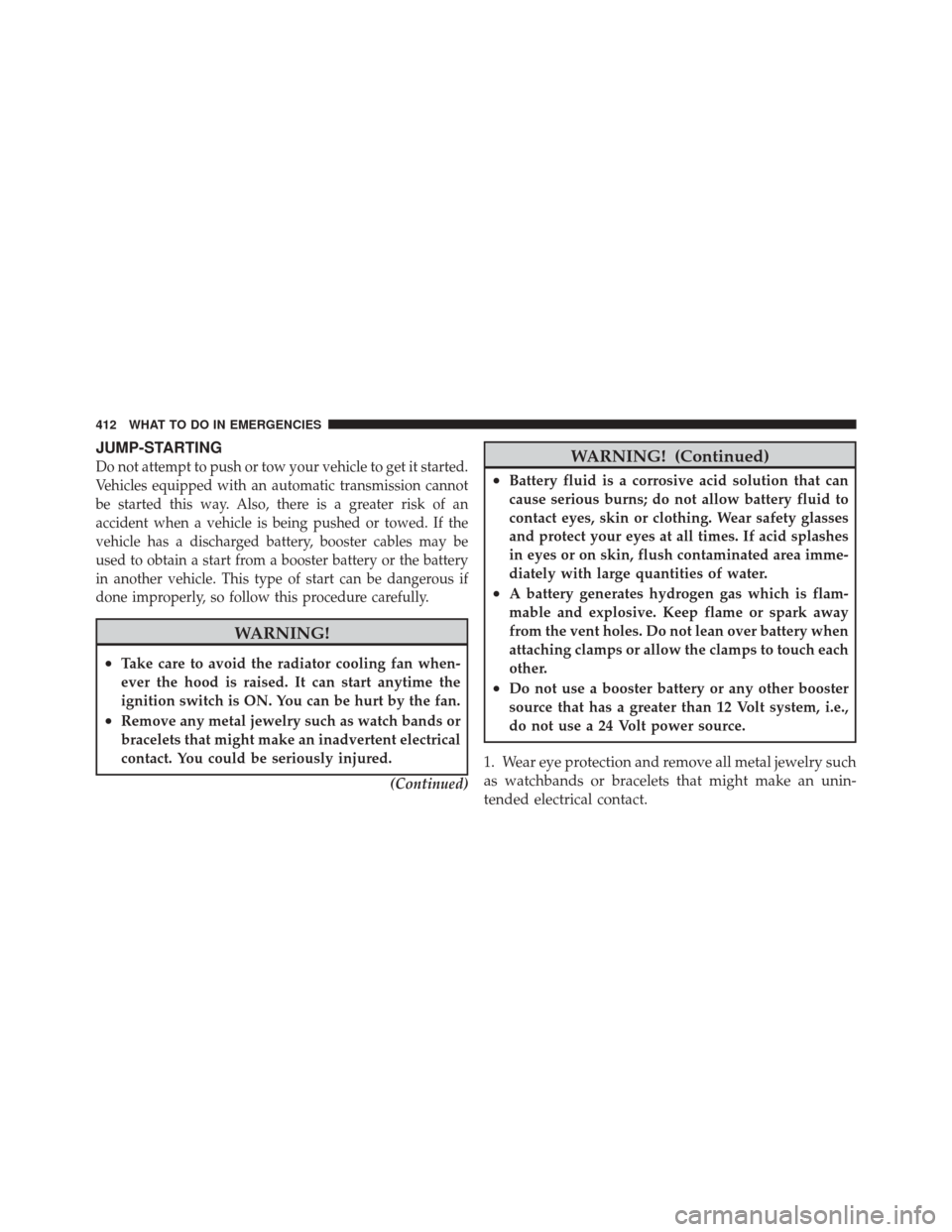
JUMP-STARTING
Do not attempt to push or tow your vehicle to get it started.
Vehicles equipped with an automatic transmission cannot
be started this way. Also, there is a greater risk of an
accident when a vehicle is being pushed or towed. If the
vehicle has a discharged battery, booster cables may be
used to obtain a start from a booster battery or the battery
in another vehicle. This type of start can be dangerous if
done improperly, so follow this procedure carefully.
WARNING!
•Take care to avoid the radiator cooling fan when-
ever the hood is raised. It can start anytime the
ignition switch is ON. You can be hurt by the fan.
•Remove any metal jewelry such as watch bands or
bracelets that might make an inadvertent electrical
contact. You could be seriously injured.(Continued)
WARNING! (Continued)
•Battery fluid is a corrosive acid solution that can
cause serious burns; do not allow battery fluid to
contact eyes, skin or clothing. Wear safety glasses
and protect your eyes at all times. If acid splashes
in eyes or on skin, flush contaminated area imme-
diately with large quantities of water.
•A battery generates hydrogen gas which is flam-
mable and explosive. Keep flame or spark away
from the vent holes. Do not lean over battery when
attaching clamps or allow the clamps to touch each
other.
•Do not use a booster battery or any other booster
source that has a greater than 12 Volt system, i.e.,
do not use a 24 Volt power source.
1. Wear eye protection and remove all metal jewelry such
as watchbands or bracelets that might make an unin-
tended electrical contact.
412 WHAT TO DO IN EMERGENCIES
Page 414 of 522
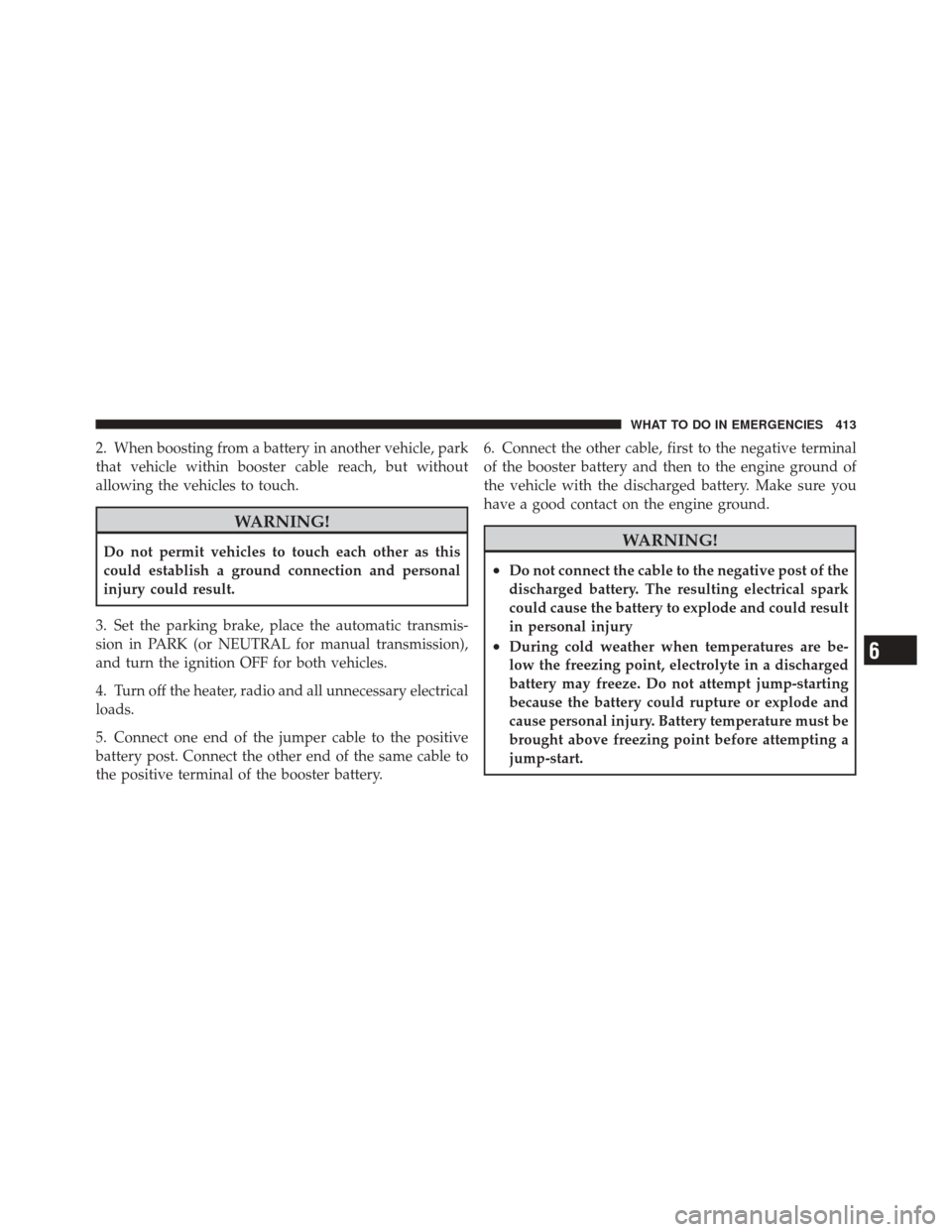
2. When boosting from a battery in another vehicle, park
that vehicle within booster cable reach, but without
allowing the vehicles to touch.
WARNING!
Do not permit vehicles to touch each other as this
could establish a ground connection and personal
injury could result.
3. Set the parking brake, place the automatic transmis-
sion in PARK (or NEUTRAL for manual transmission),
and turn the ignition OFF for both vehicles.
4. Turn off the heater, radio and all unnecessary electrical
loads.
5. Connect one end of the jumper cable to the positive
battery post. Connect the other end of the same cable to
the positive terminal of the booster battery. 6. Connect the other cable, first to the negative terminal
of the booster battery and then to the engine ground of
the vehicle with the discharged battery. Make sure you
have a good contact on the engine ground.WARNING!
•Do not connect the cable to the negative post of the
discharged battery. The resulting electrical spark
could cause the battery to explode and could result
in personal injury
•During cold weather when temperatures are be-
low the freezing point, electrolyte in a discharged
battery may freeze. Do not attempt jump-starting
because the battery could rupture or explode and
cause personal injury. Battery temperature must be
brought above freezing point before attempting a
jump-start.6
WHAT TO DO IN EMERGENCIES 413
Page 415 of 522
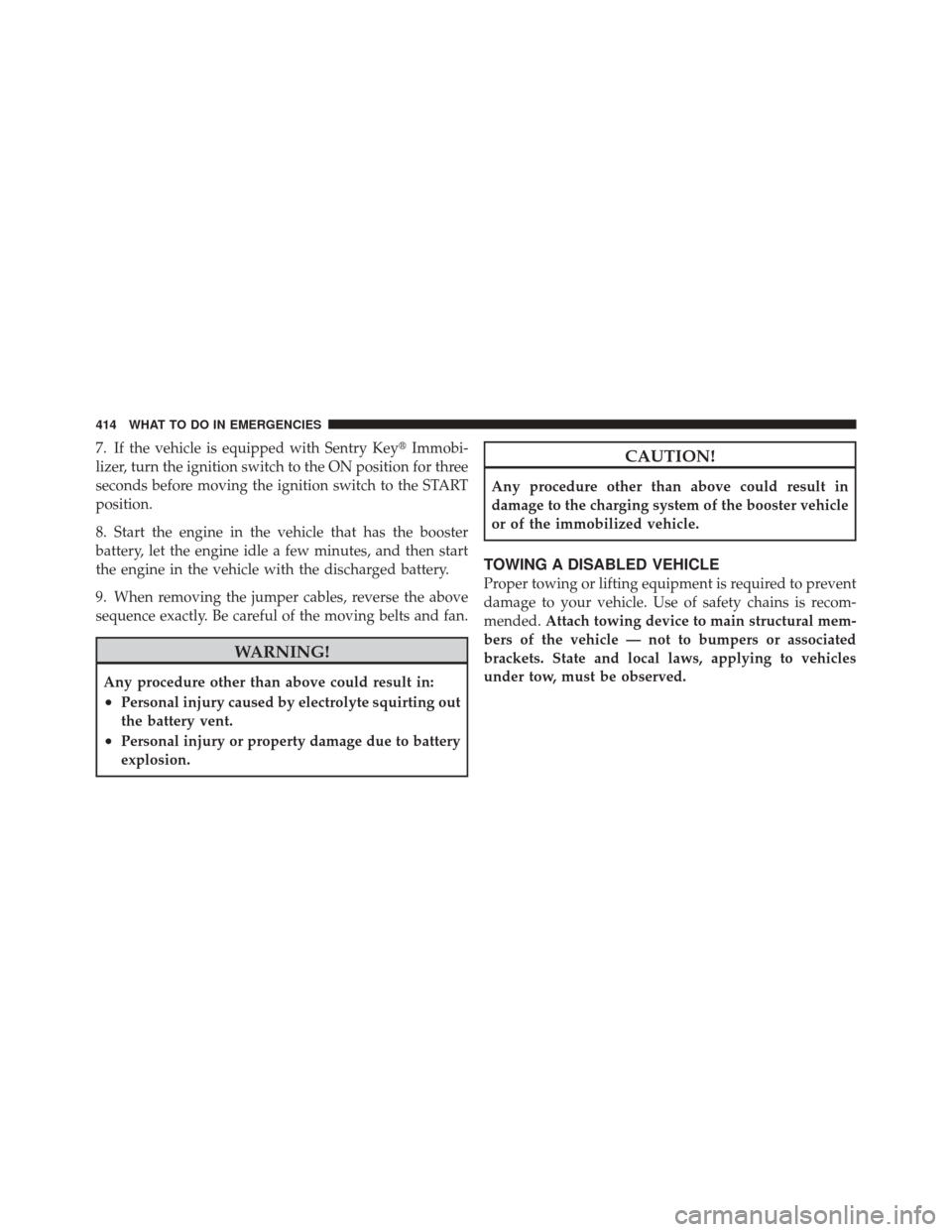
7. If the vehicle is equipped with Sentry Key�Immobi-
lizer, turn the ignition switch to the ON position for three
seconds before moving the ignition switch to the START
position.
8. Start the engine in the vehicle that has the booster
battery, let the engine idle a few minutes, and then start
the engine in the vehicle with the discharged battery.
9. When removing the jumper cables, reverse the above
sequence exactly. Be careful of the moving belts and fan.
WARNING!
Any procedure other than above could result in:
•Personal injury caused by electrolyte squirting out
the battery vent.
•Personal injury or property damage due to battery
explosion.
CAUTION!
Any procedure other than above could result in
damage to the charging system of the booster vehicle
or of the immobilized vehicle.
TOWING A DISABLED VEHICLE
Proper towing or lifting equipment is required to prevent
damage to your vehicle. Use of safety chains is recom-
mended. Attach towing device to main structural mem-
bers of the vehicle — not to bumpers or associated
brackets. State and local laws, applying to vehicles
under tow, must be observed.
414 WHAT TO DO IN EMERGENCIES
Page 418 of 522
MAINTAINING YOUR VEHICLE
CONTENTS
�Engine Compartment — 3.7L ............. 419
� Onboard Diagnostic System — OBD II ...... 420
▫ Loose Fuel Filler Cap Message ........... 420
� Emissions Inspection And Maintenance
Programs ............................ 421
� Replacement Parts ..................... 422
� Dealer Service ........................ 423
� Maintenance Procedures ................. 423
▫ Engine Oil ......................... 424 ▫
Engine Oil Filter ..................... 427
▫ Engine Air Cleaner Filter ............... 427
▫ Maintenance-Free Battery .............. 428
▫ Air Conditioner Maintenance ............ 429
▫ A/C Air Filter — If Equipped ........... 430
▫ Body Lubrication .................... 431
▫ Windshield Wiper Blades ............... 431
▫ Adding Washer Fluid ................. 432
▫ Exhaust System ..................... 433
7
Page 420 of 522
ENGINE COMPARTMENT — 3.7L
1 — Air Cleaner Filter6 — Washer Fluid Reservoir
2 — Engine Oil Dipstick 7 — Engine Coolant Reservoir
3 — Brake Fluid Reservoir 8 — Engine Oil Fill
4 — Integrated Power Module 9 — Coolant Pressure Cap
5 — Battery
7
MAINTAINING YOUR VEHICLE 419
Page 422 of 522
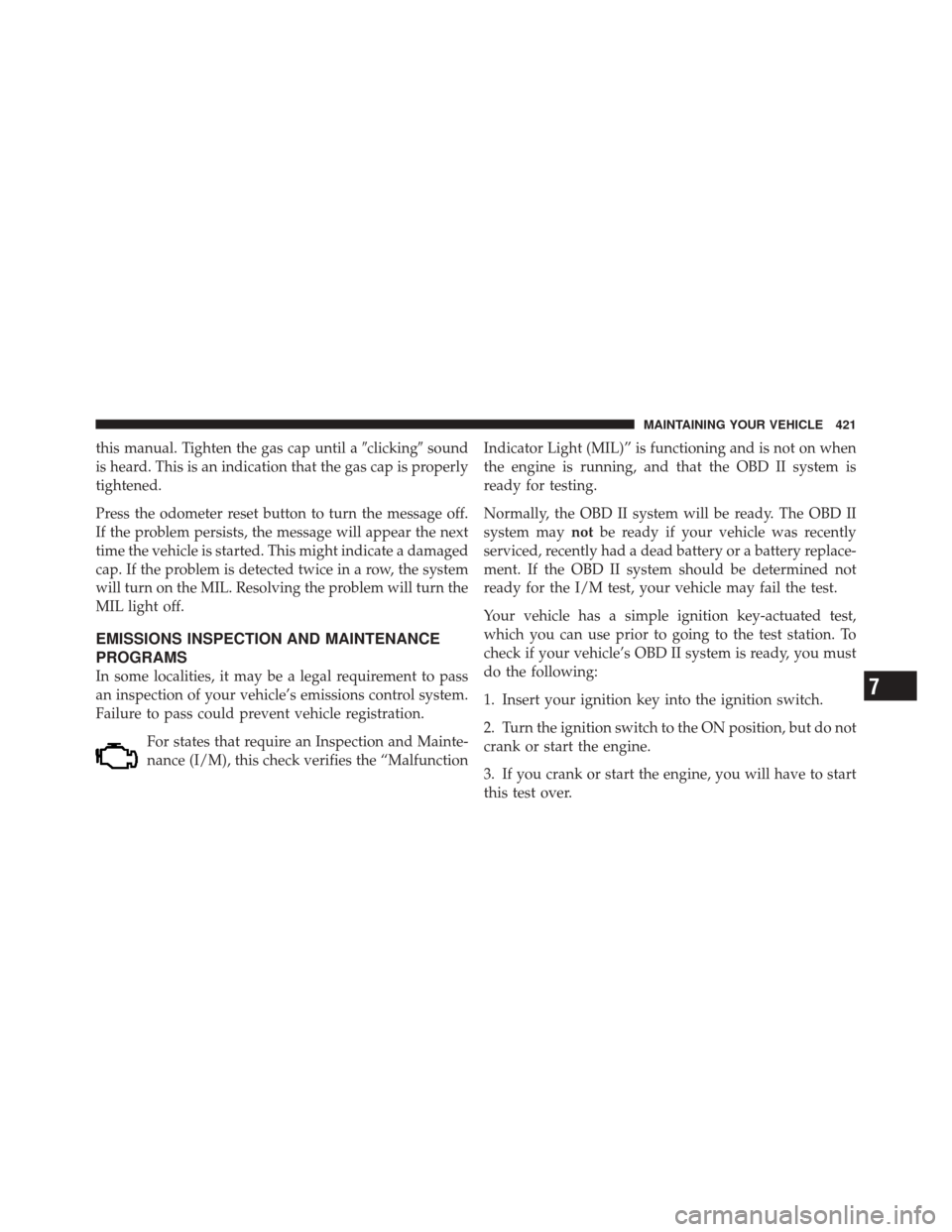
this manual. Tighten the gas cap until a�clicking�sound
is heard. This is an indication that the gas cap is properly
tightened.
Press the odometer reset button to turn the message off.
If the problem persists, the message will appear the next
time the vehicle is started. This might indicate a damaged
cap. If the problem is detected twice in a row, the system
will turn on the MIL. Resolving the problem will turn the
MIL light off.
EMISSIONS INSPECTION AND MAINTENANCE
PROGRAMS
In some localities, it may be a legal requirement to pass
an inspection of your vehicle’s emissions control system.
Failure to pass could prevent vehicle registration.
For states that require an Inspection and Mainte-
nance (I/M), this check verifies the “Malfunction Indicator Light (MIL)” is functioning and is not on when
the engine is running, and that the OBD II system is
ready for testing.
Normally, the OBD II system will be ready. The OBD II
system may
notbe ready if your vehicle was recently
serviced, recently had a dead battery or a battery replace-
ment. If the OBD II system should be determined not
ready for the I/M test, your vehicle may fail the test.
Your vehicle has a simple ignition key-actuated test,
which you can use prior to going to the test station. To
check if your vehicle’s OBD II system is ready, you must
do the following:
1. Insert your ignition key into the ignition switch.
2. Turn the ignition switch to the ON position, but do not
crank or start the engine.
3. If you crank or start the engine, you will have to start
this test over.7
MAINTAINING YOUR VEHICLE 421